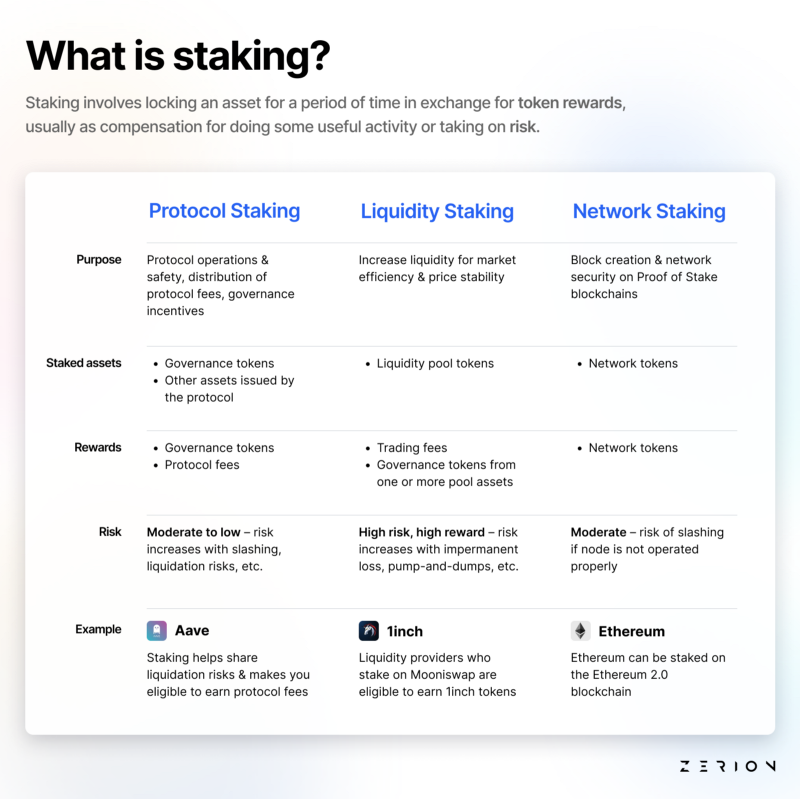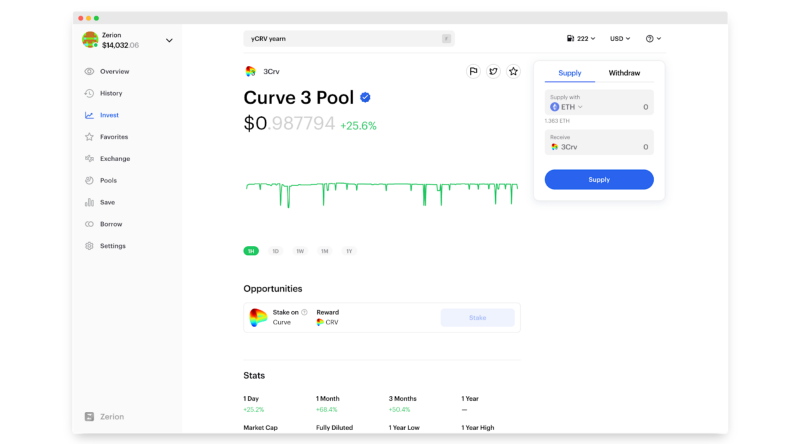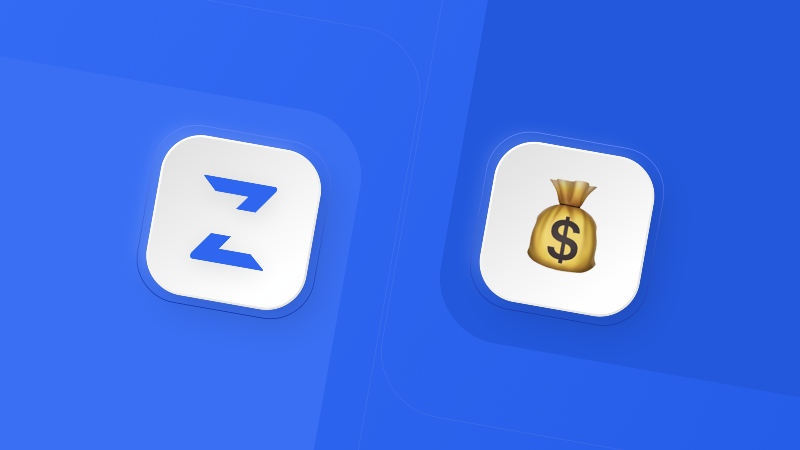Staking is one of the most powerful ways to earn passive income on your crypto — and play an active role in building the future of decentralized finance (DeFi)
Zerion now makes it easier to power up your DeFi portfolio with automatic staking detection on almost every asset you own.
Staking is one of the easiest ways to put your crypto to work with moderate risk — but what does it actually mean?
Crypto is notorious for intimidating jargon, so in this article, we’ll break down different kinds of staking and discuss the risks and return associated with each. This includes protocol staking, liquidity staking and network staking.
What is staking? 💰
In short, staking is when you lock an asset for a period of time in exchange for token rewards, usually as compensation for doing some useful activity or taking on a certain level of risk. Rewards are dependent on several factors, such as the proportion of tokens you stake and the duration for which you stake them. Protocols might incentivize staking for different reasons:
- Protocol staking. Staking is incentivized to maintain protocol safety, facilitate decentralized governance, and/or act as a distribution channel for protocol earnings (dividends).
- Liquidity staking. Locked assets increase liquidity in the market and therefore contribute to minimizing price volatility.
- Network staking. On Proof-of-Stake (POS) blockchains, block transactions are validated by miners who stake their coins on the network. This includes liquid staking with Lido or Rocket Pool, which run validators on behalf of stakers.
Staking can also serve a combination of these purposes, as we’ll see in some of the examples below.
Protocol staking
Locking your assets can help maintain the smooth operation and safety of a protocol, facilitate decentralized governance, or act as a distribution channel for protocol earnings (similar to dividends).
For example, locked assets on lending and borrowing protocols like Aave help share liquidation risks. In return, stakers receive a share of protocol fees. If something were to go wrong, the staked share would be used as insurance and therefore reduced in order to return the protocol to normal.
Protocol operations and decentralized governance often go hand-in-hand:
- Staking $1INCH makes you eligible for governance rights, AMM fees and dividends from positive slippage on the 1inch protocol.
- When you stake $CRV governance tokens on Curve, you are given $veCRV which simply stands for “vote-escrowed CRV”. Stakers who hold $veCRV are offered several governance privileges, such as earning an additional 50% admin fee on trading fees and voting on proposals in the Curve DAO.
- Staked $ZRX can be used for market-making on the 0x protocol
- Staked $UMA helps ensure accurate price oracles on the UMA protocol
Other protocols with similar staking incentives include Balancer, Kyber and SushiSwap.
Liquidity staking
Staking rewards can also be used as an incentive to increase liquidity and ensure price stability. This kind of staking is commonly referred to as “liquidity mining” and is a popular feature on decentralized exchange (DEX) and automated market maker (AMM) protocols like Uniswap, Sushiswap, Balancer and 1inch, as well as stablecoin protocols like Ampleforth, Liquity and Fei.
When you deposit assets to a liquidity pool and stake your tokenized pool shares, you are eligible to earn both trading fees and staking rewards. This is because as a liquidity provider, you face asset risk (by supplying your own tokens to the pool) and volatility risk (because price swings can lead to impermanent loss). In exchange for this “work”, you are rewarded with:
- Trading fees e.g. Uniswap V2 offers a 0.03% fee to anyone who supplies liquidity to a token pair
- Staking rewards in the form of governance tokens
For example, when you contribute liquidity to the DPI/ETH Uniswap pool and stake your DPI/ETH shares, you’ll be rewarded in $INDEX, the governance token that powers the Index Coop DAO.
Network staking
Network validation is one of the oldest staking functions.
First, let’s have a quick refresher of how Proof of Work (PoW) blockchains like Bitcoin reach consensus. In PoW blockchains, validators known as “miners” solve complex mathematical puzzles to authenticate transactions. As a reward for their computational work and the utility expenses that go into running a mining node, they are paid in network tokens. Back in 2012, it may have made sense for you to run a bitcoin mining operation from your college dorm room, but nowadays the process is so energy-intensive that it is dominated by conglomerate mining farms who sometimes use more electrical power than entire countries.
Enter Proof of Stake (PoS) blockchains. Here, unlike PoW blockchains, validators are selected and rewarded based on the proportion of tokens they hold in the network. Theoretically, anyone can stake and earn.
But staking for network validation isn’t always straightforward. For example, Ethereum 2.0 has a minimum staking threshold of 32 ETH. However, not everyone has that amount of ETH sitting around or the technical know-how to actually set up a node.
DeFi protocols and some centralized exchanges can therefore act as a staking custodian, where they remove the technical difficulties and act as a network validator on your behalf — your only job is to lock assets in your wallet.
To summarize, here’s how different kinds of staking compare:

Combined staking strategies
Decentralized finance is about programmable, composable money, so of course, staking strategies can be combined and tokenized. “Wrapped staked tokens” like stETH, xKNC and xAAVE are tradeable on secondary markets and confer risk, governance participation, and/or node validation to a third party. Staking rewards are then split between investors who hold the wrapped staked tokens and the creator of those tokens.
Another approach is when two or more protocols combine staking strategies to achieve several goals. For example, when you stake Aave Balancer pool shares, you are rewarded in BAL (the governance token behind Balancer protocol) and AAVE (the governance token behind the AAVE protocol).
How is staking different from yield farming?
Staking is a gateway to more complex DeFi investing strategies like yield farming. However, there are a few important differences.
Yield farming is a recursive investment strategy that employs lending, borrowing and liquidity staking in order to maximize profits through interest earned and governance token rewards.
Staking is a much safer passive investment strategy because it doesn’t involve any borrowing at high-risk interest rates or collateral ratios.
When you stake your assets, they stay locked in a smart contract and your only risk exposure is the safety of the token(s) or protocol itself.
Stake and earn with Zerion
Zerion’s staking feature will automatically show up for you on asset pages that are eligible for staking opportunities, making passive income as easy as a few clicks.
For example, if you hold 3CRV pool shares, these can be staked on Zerion to passively earn CRV governance tokens.

Not sure where to start? Install Zerion Wallet and find the best staking opportunities.
FAQ
How to build a staking strategy?
To build a staking strategy, balance yield and risk by considering slashing penalties, lock-up periods, and validator reliability. Diversify across networks or validators to reduce exposure and decide whether to reinvest rewards or withdraw them. Be mindful of gas fees and transaction costs, as they can impact your overall returns.
How to track staking rewards?
You can track staking rewards through your wallet with built-in portfolio tracking like Zerion. Zerion will automatically find all your staked positions and rewards across 40+ supported chains.
How to stake with minimal bridging risk?
To reduce bridging risk when staking, use native staking whenever possible instead of bridged assets. If bridging is necessary, choose secure, audited bridges and transfer funds in smaller amounts. Always check liquidity, unstaking options, and potential delays before committing funds. Some platforms also offer insurance against bridge failures for added protection.


